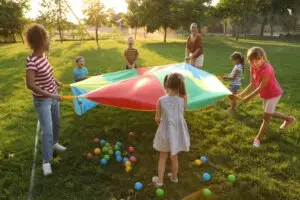Using and Teaching Active Listening in Children’s Groups
May 24, 2024

This blog is part of a series on Fostering Healthy Minds in Children at Church that provides strategies children’s leaders can use to foster healthy minds in children to whom they minister. And, hey, you may even pick up a tip or two to help those in your personal circles! If you’re new to the series, we encourage you to check out the introduction here.
“YOU’RE NOT LISTENING!” How many of us are guilty of this statement (raises own hand)? We often judge a child’s (or adult’s) listening based on what we see or don’t see — think “eyes on me.” Plot twist: That is not always indicative of a person’s ability to pay attention or listen.
Some children (and adults) do not need to make eye contact in order to pay attention. In fact, research shows that forcing a child with autism or anxiety to make eye contact actually reduces their ability to feel safe and listen to what you are saying.
Think about it: If I am already anxious and then also forced to look at you in the eye, I am no longer thinking about what you are saying. I am now in panic mode or focused on how uncomfortable I am.
Additionally, one of the most commonly diagnosed mental health disorders, in conjunction with anxiety, is attention deficit hyperactivity disorder (ADHD). A child with ADHD is likely not able to sit and listen in the way a “typical” child would. A child with ADHD likely needs to be fidgeting, walking, bouncing, etc., in order to process and hear what you are saying.
Using and Teaching Active Listening
If we want to make sure children are listening when we lead missions discipleship, we have to reframe our mindset to the goal of them actually listening, not just the appearance of what we consider “normal” listening.
How do we accomplish this?
First of all, take time to know the children in your group. Observe the way they interact with you and others during lesson times, games, crafts, etc. Consider what they do and think about why they may be doing it, instead of negatively assuming or immediately reprimanding. If you have questions, don’t be afraid to ask parents for help to ensure you are communicating and interacting in a way that best serves the child and the group as a whole.
Second, there are things you can do to make sure children are attentive. If you think a child is distracted or not paying attention, ask them (nicely) to summarize what you said. Encourage them when/if they get it right! For example: I am so glad you showed me you were listening!
Some children may need you to repeat what you just said, allowing them more time to process it and for it to stick. Also, one of my favorite activities to help children listen is to give them a word to listen for. For example: Jump up when you hear me say the word pray during the story.
What Active Listening Is Not
Now, the hard-and-fast rules of what active listening is not — this is true for children and adults in your group:
- Active listening is not texting and scrolling social media while someone is talking to you.
- Active listening is not typing and working on things while someone else has something to tell you.
- Active listening is not talking to your friends while the leader (or another group member) is talking.
There is a line between helping and hurting when it comes to attention and listening. However, getting to know the children in your group and understanding them, coupled with some positive and proactive methods to help children, will encourage healthy listening and a positive atmosphere within your group.
Brooklyn Hancock is Licensed Mental Health Counselor, Registered Play Therapist, mom, and former Certified School Counselor. Her passions are working with children, adolescents, teens, adults, and parents to navigate life’s toughest challenges.
Disclaimer: The information shared on wmu.com is not meant to diagnose or treat a mental health condition. We encourage you to follow up with your health-care provider and seek a mental health professional for individual consultation and care.













